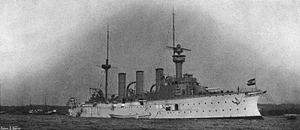 Vineta in 1902
| |
| History | |
|---|---|
| Name | Vineta |
| Namesake | SMS Vineta |
| Builder | Kaiserliche Werft, Danzig |
| Laid down | 1896 |
| Launched | 9 December 1897 |
| Commissioned | 13 September 1899 |
| Stricken | 6 December 1919 |
| Fate | Scrapped in 1920 |
| General characteristics | |
| Class and type | Victoria Louise-class protected cruiser |
| Displacement | |
| Length | 110.5 m (363 ft) |
| Beam | 17.6 m (58 ft) |
| Draft | 7.08 m (23.2 ft) |
| Installed power |
|
| Propulsion |
|
| Speed | 19.6 knots (36.3 km/h; 22.6 mph) |
| Range | 3,412 nmi (6,319 km; 3,926 mi) at 12 knots (22 km/h; 14 mph) |
| Complement |
|
| Armament |
|
| Armor |
|
SMS Vineta was a protected cruiser of the Victoria Louise class, built for the German Imperial Navy (Kaiserliche Marine) in the 1890s. Vineta was laid down at the AG Vulcan shipyard in 1895, launched in April 1897, and commissioned into the Navy in July 1898. The ship, named for the earlier screw frigate SMS Vineta, was armed with a battery of two 21 cm guns and eight 15 cm guns and had a top speed of 19 knots (35 km/h; 22 mph). Though the five Victoria Louise-class cruisers proved to be disappointing in some ways, they marked the beginning of a decade of German cruiser construction.
Vineta served abroad in the American Station for the first several years of her career. During her deployment in the Americas, she participated in the Venezuela Crisis of 1902–1903 and shelled several Venezuelan fortresses, including the bombardment of Fort San Carlos. Notably, the ship suffered an ammunition fire during the cruise, which informed the navy about the instability of its propellant charges, leading to reformulation that spared several German warships from destruction during battles in World War I. Vineta returned to Germany in 1905, by way of the country's colonies in German South West Africa and German West Africa. She was used as a torpedo training ship from 1906 to 1908.
She was modernized in 1909–1911, after which she was used as a training ship for naval cadets, conducting training cruises in the early 1910s. In November 1912, while cruising in the Mediterranean Sea, she participated in an international naval protest of the First Balkan War. During another training voyage to the Caribbean Sea in early 1914, she embarked the deposed Haitian president Michel Oreste as he fled into exile. At the outbreak of World War I later in 1914, Vineta was mobilized into V Scouting Group, but served in front-line duty only briefly. She was used as a barracks ship after 1915, and ultimately sold for scrapping in 1920.